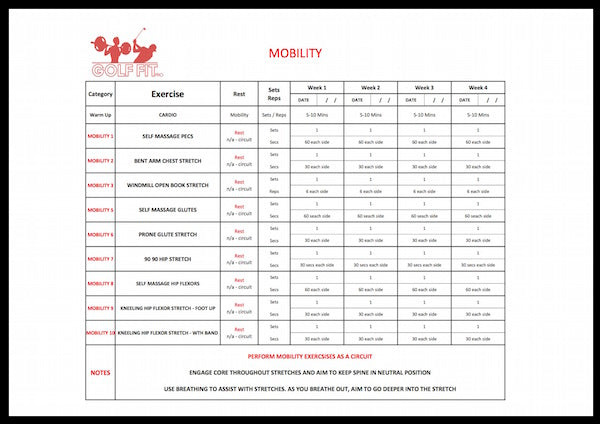In this series of five articles, I will be offer guidelines for golf-specific physical activity aimed at five different golfing demographics:
- Kids
- Teenagers
- Club Players
- Elite Players
- Senior Players
This article is for elite amateur golfers and professionals. Once the foundation of physical competence has been laid down through solid gym and posture work, then it’s time to consider what physical characteristics are actually desirable to compete in golf at the highest level. In my opinion, golfers need a solid level of cardiovascular fitness, good flexibility and as much strength and power as possible along with great movement patterns. They also need to be able to manage their own body while on the road competing in tournaments.
In order to develop these capabilities I prescribe the following:
Gym work
Elite golfers need a program that focuses on strength and power while solidifying the work already done on stability and mobility. Below is an example lower-body workout from an intermediate/advanced-level program. The function exercises are included for stability and muscle activation, while the power exercises are simple jump and throw variations, focusing on generating speed. The strength work is designed for hypertrophy and focuses on multi-joint lifts. The core exercises incorporate a loaded rotation movement and a bracing, endurance hold.

Example workout from a semi-advanced program, this session focuses on legs.
Motor Pattern Program
At this stage, drills using the GravityFit TPro and other postural training aids are directly related to the player’s swing and what they are trying to achieve from a technical standpoint. Here is an example of one my favourite drills to train lower body stability and dynamic rotation.
Flexibility
Exercises are prescribed using spiky balls and the corresponding stretches, usually targeting ankle, hip, shoulder and spinal mobility. Below is a typical mobility program that covers the key areas that are commonly affected by a predominantly sitting lifestyle combined with lots of practice and play.

A release program for key postural areas, with a combination of myofascial release and stretching.
Cardiovascular Work
Interval training is used to keep the energy output down while still stimulating the cardiovascular system and improving aerobic and anaerobic endurance. Here is a short but intense Tabata workout that is typical of the cardio work I prescribe.

A combo of rowing and treadmill sprints done at high intensity for short durations.
Maintenance On the Road
A combination of basic gym work, posture and mobility exercises are combined with recovery practices such as hydrotherapy while traveling and attending tournaments. These techniques are used to help maintain the condition that has been developed in the prep phase before tournaments.
Cameron Smith, PGA Tour Winner performing his warm up using the GravityFit TPro and lateral resistance band
The individual application can vary quite considerably within this approach depending on the individual. I’ll present two methods I have used in dealing with a couple of different players:
- Golfer 1: A young professional who has been under my care since the age of 16.
- Golfer 2: An established professional in his 30s that I have been working with for around 18 months.
Golfer 1 has come through a state high-performance program, so he is used to having information delivered to him and is expected to comply with the instructions and programs delivered. Best practice is always used, compliance is high and progress is measurable and very consistent. It’s essentially an ideal scenario for a trainer as long-term development is the main focus and priority, sometimes at the expense of short-term performance.
Golfer 2 has come through a route that is much more self-learned and self-taught. The approach therefore has to be softened somewhat and worked in with the player’s current belief system. Exercises have to be adapted and programs changed or moulded in order to develop the player’s athleticism, while not rocking the boat from a conceptual point of view. Remember at this stage, short-term performance is considered to be the highest priority and long-term development often has to take a back seat.
Best practice with Golfer 2 and those like him is sometimes compromised, and progress is often not very measurable. This is a small price to pay in order to keep a player’s belief high and ensure compliance is achieved. Without belief and compliance, results will not happen and I might as well prescribe aqua aerobics, calf raises and wrist curls!
In summary, at the elite level, the focus should be on strength and power, cardio fitness, flexibility, swing-specific motor patterns and body maintenance skills. The individual approach has to be highly customized and specific to the player in question.
If you would like to access training programs designed for elite players, then check out the following products and services from Nick at Golf Fit Pro:


Great article!
Leave a comment